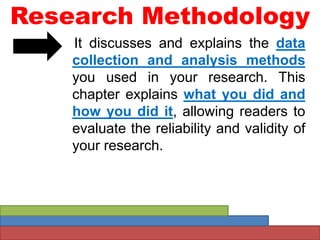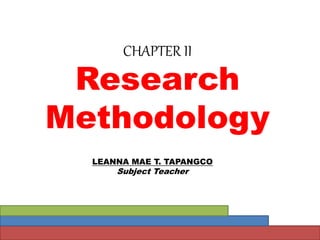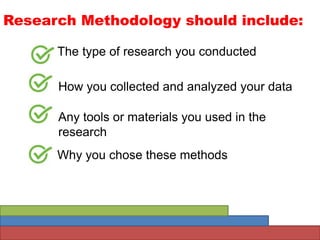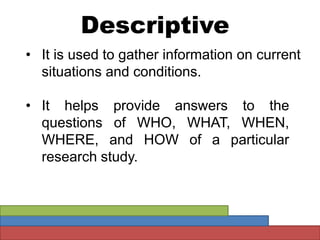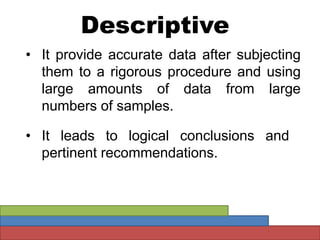Chapter 2- Research Design.pptx
- 1. Research Methodology It discusses and explains the data collection and analysis methods you used in your research. This chapter explains what you did and how you did it, allowing readers to evaluate the reliability and validity of your research.
- 2. CHAPTER II Research Methodology LEANNA MAE T. TAPANGCO Subject Teacher
- 3. Research Methodology should include: The type of research you conducted How you collected and analyzed your data Any tools or materials you used in the research Why you chose these methods
- 4. Types of Quantitative Research Design Exploratory Descriptive Causal
- 5. Activity: Arrange the following parts of Research Methodology in order. Research Design Locale and Population of Study Instrumentation and data Collection Tools for data Analysis Data Categorization Ethical Consideration
- 6. Types of Quantitative Research Design Exploratory It is often used to establish an initial understanding and background information about a research study of interest, often with very few or earlier related studies found relevant to the research study.
- 7. Exploratory ? It is described as informal or unstructured way of investigating available sources. ? It is a research used to investigate a problem which is not clearly defined. It is conducted to have a better understanding of the existing problem, but will not provide conclusive results.
- 8. Descriptive ? It is used to gather information on current situations and conditions. ? It helps provide answers to the questions of WHO, WHAT, WHEN, WHERE, and HOW of a particular research study.
- 9. Descriptive ? It provide accurate data after subjecting them to a rigorous procedure and using large amounts of data from large numbers of samples. ? It leads to logical conclusions and pertinent recommendations.
- 10. Types of Research design: Survey Correlation Evaluation
- 11. Activity: Compare the three types of Descriptive Research Survey Correlation Evaluation
- 12. Survey ? It is usually used in securing opinions and trends through the use of questionnaires and interviews. ? A survey is used in gathering data from institutions, government, and business to help in decision- making regarding change of strategies, improving practices and so on.
- 13. Correlation ? It is used for research studies aimed to determine the existence of a relationship between two or more variables and to determine the degree of relationship. ? Quantitative variable that can be correlated: Mental ability and math grade; gender and math grade; income and expenses
- 14. Evaluation ? It is conducted to elicit useful feedback from a variety of respondents from various fields to aid in decision making or policy making. ? Commonly used types of evaluation based on the purpose of the study are FORMATIVE and SUMMATIVE evaluation.
- 15. Evaluation ? FORMATIVE EVALUATION is used to determine the quality of implementation of a project, the efficiency and effectiveness of a program, assessment or organizational process such as procedures, policies, guidelines, human resource development, and the like.
- 16. Evaluation ? SUMMATIVE EVALUATION is done after the implementation of program. It examines the outcomes, products or effects of the program.
- 17. Causal ? It is used to measure the impact that an independent variable (Causing effect) has on another variable (being affected) or why certain results are obtained. ? It can also be used to identify the extent and nature of cause and effect relationships.
